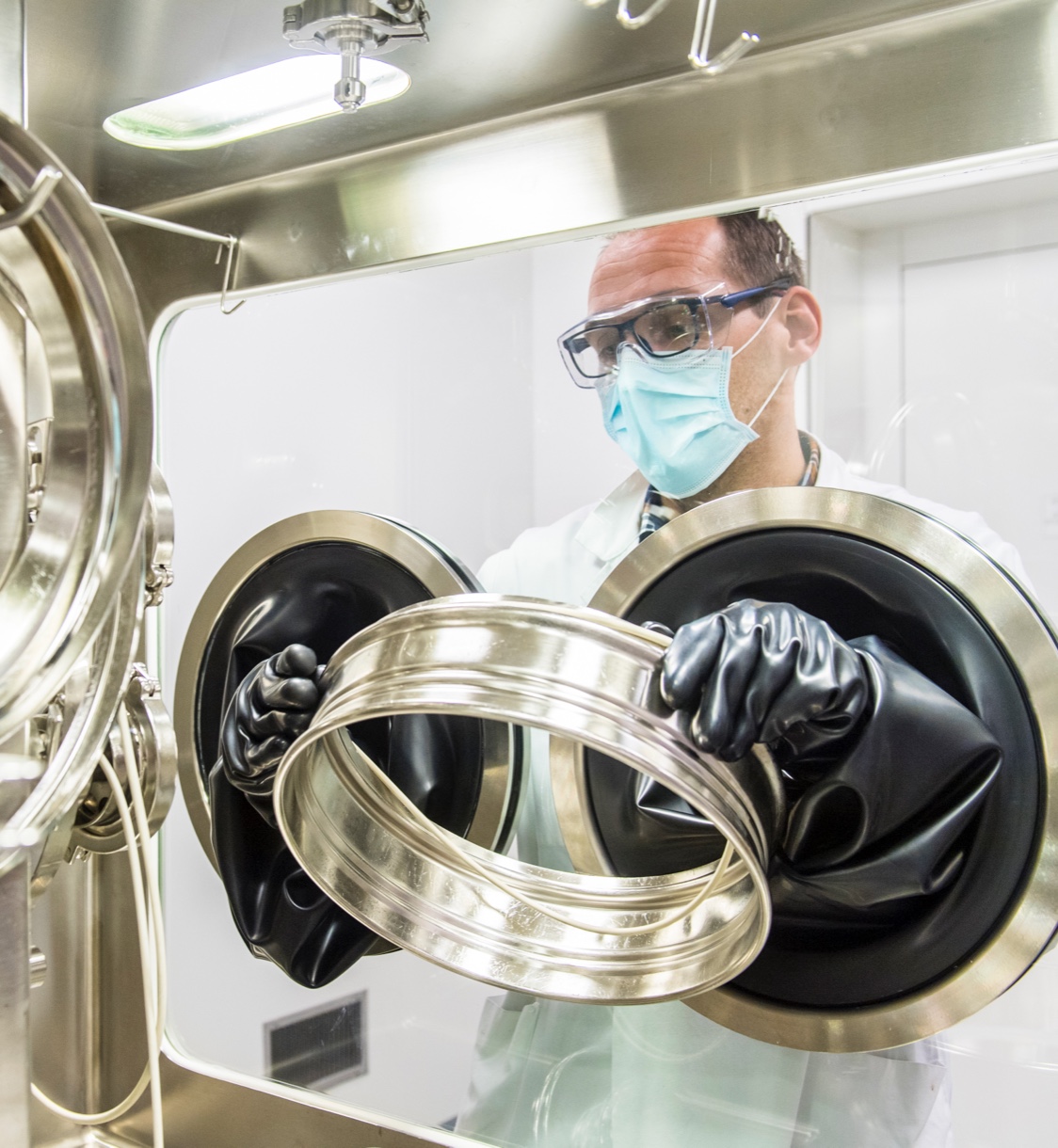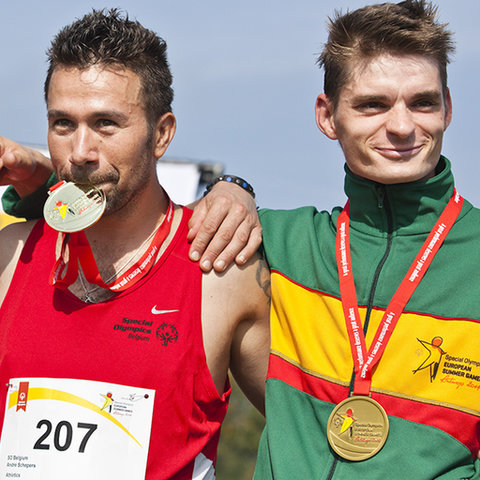How we bring our treatments to patients
How we bring our treatments to patients
The drugs, therapies and vaccines we develop only have value when they actually reach patients. Thus, we strive to make all of our innovations available worldwide. From the R&D scientist who investigates a new molecule to the data specialist or the supervisor of a clinical study: this is the basis of the motivation of every colleague who works for Janssen. One of the final steps in the process of making these innovative developments widely accessible is the reimbursement. As we do in many other fields, we work together with governments, competent bodies and administrations, universities, healthcare professionals and numerous other partners.
If after extensive clinical research, a new therapy, drug, or vaccine is found to be effective and safe, we submit it to the European Medicines Agency (EMA) for approval. For most innovative treatments, the European Commission makes a decision on approval in the member states of the European Union based on a positive opinion from the EMA. In the subsequent phase, the individual member states are responsible, in close consultation with our company, for ensuring that their citizens have rapid access to these innovative treatments thanks to reimbursement. In Belgium, this responsibility lies with the Committee for the Reimbursement of Medicines, established within the National Institute for Health and Disability Insurance. The final decision is taken by the Federal Minister of Social Affairs, although many other entities and persons are involved throughout the process. You can read more about this later in this chapter.

The added value of our treatments
Our medicines and therapies add value to the lives of patients, the healthcare system and society. In recent years, medical innovation has led to ever-increasing health gains, higher survival rates and increased life expectancy. Thus, when determining the value of a new treatment, we primarily look at the extent to which it can improve the health and/or well-being of patients compared to existing standard care. This involves not only comparing with other drugs and therapies, but also taking into account, for example, a simpler form of administration or increased ease of use. Reducing the number of operations, hospital admissions or preventing long-term care also play a role. These are some of the positive effects of treatment that can reduce the pressure on the healthcare system. Finally, we take into account the added value to society, for example, when patients or informal caregivers can resume their jobs and participate more actively in society thanks to our treatment.
There are also important differences between medical innovations. The use of vaccines within a preventive strategy is best viewed from a different perspective. Vaccines are administered to healthy individuals to protect them against certain infectious diseases. On a societal level, a high vaccination rate can lead to reduced pressure on hospitals and healthcare providers, a society without (economic) constraints, and more time and resources within the healthcare system for patients with other conditions.
We are continuously working on ways to increase and better map the added value of our therapies, medicines, and vaccines. We do this, for example, using real-world data (RWD): data we collect on the efficacy and safety of all these different treatments in daily practice. Read more about this in chapter 8, ‘Added value in practice’.
50%
In a large group of 2,981 patients with multiple myeloma (Kahler’s disease), a 50% improvement in overall life expectancy was observed: in addition to improvements in supportive care, innovative medicines made an important contribution to this extended life expectancy.1
Improvement of life quality
The introduction of biologics – the so-called biologicals – has had a tremendous impact on the lives of people suffering from psoriasis2 or Crohn’s disease3, for example. The impact on the quality of life of these patients has improved considerably. Fortunately, today there are many treatments that allow patients to control the effects of these conditions. In fact, research shows that patients with psoriasis not only became more productive4 thanks to a new biological drug, but also saw their feelings of anxiety and depression reduced.5

An appropriate stimulus to innovation
As a healthcare company in a global market, it is essential that we keep our innovation cycle going. With proceeds from existing treatments, we fund large, long-term and risky investments in solutions to tomorrow’s health challenges. For example, only 1 molecule in 10,000 ultimately makes it as a final approved drug. The focus in drug development is also shifting to more personalized medicine and more advanced treatments such as cell and gene therapies. These trends make researching new drugs even more challenging, risky, and capital intensive than before.6 The average development cost of an innovative treatment is between 2.1 and 2.5 billion euros.
Janssen invested 2.2 billion euro in research and development (R&D) in 2020. This makes us the largest private R&D investor in Belgium.7 In order to keep investing in drug development attractive and to maintain our top position as an investor in R&D in Belgium and Europe, a climate that prioritizes innovation in healthcare is crucial. This objective is expressed in many areas. We must not only ensure that the necessary and targeted investments continue to find their way to our country. Attracting top scientific talent, preparing for future trends in healthcare and setting up clinical studies in numerous disease areas are equally essential building blocks for a strong Belgian biopharmaceutical sector. Finally, by focusing on public-private partnerships within the broad Life Sciences ecosystem, we maintain this important innovation cycle.
Marleen Hoebus
External & Government Affairs Director
16% price reduction
After legally defined periods, innovative treatments lose their patent protection, after which generic variants and biosimilars become available. In Belgium, drug prices drop by up to 43% for biological drugs and 68%8 for classic drugs. Together with sustained growth of the drug budget, this again creates room for future innovation and the associated health gains.
18 months
After 18 months all patent applications will be made public. Everyone will then be able to see exactly which patent has been applied for by a company. By revealing which innovation is protected in a patent, society can build on that. Both patent expiration and price declines are part of the continuous innovation cycle for companies in the biopharmaceutical sector. It is thanks to the revenues in the first part of the cycle of a new therapy, drug or vaccine that we can continue to invest in research & development and are on the eve of yet new, promising treatments.
European market authorization
If the clinical studies show that a new innovative treatment is effective and safe, we apply for a market authorization at the European level. This authorization is valid for all member states of the European Union and is therefore also a necessary condition for bringing this therapy, medicine, or vaccine onto the Belgian market. The market authorization is granted by the European Commission but follows a thorough evaluation by the European Medicines Agency (EMA), which issues a positive opinion if necessary.
After obtaining European market authorization, we initiate the national pricing and reimbursement procedure to give patients access to these new innovative therapies as soon as possible. This process is strictly regulated: the deadlines and procedures to be followed have been laid down in law, step by step. Moreover, reimbursement agreements are always reached in close consultation with the government.
List price
The first step we take to market our approved treatment is to determine the 'list price', which is the so-called maximum price. We submit this application to the Price Commission of the Federal Public Service (FPS) Economy. On the advice of the Price Commission for Proprietary Medicines, the Federal Minister for Economy decides whether this price determination is approved. Many different entities sit on this price commission, including the Federal Agency for Medicines and Health Products (FAMHP), the NIHDI and social partners. When determining the list price, our starting point is to get drugs, therapies, and vaccines to the patient as quickly as possible at a fair price.
Committee for the Reimbursement of Medicines
The evaluation of the reimbursement of a new treatment is carried out within the NIHDI, the National Institute for Health and Disability Insurance, by the Commission for the Reimbursement of Medicines, or CRM for short. The reimbursement procedure within the CRM is started up in parallel with the price determination procedure at the Price Service of the FPS Economy. The CRM is made up of specialists and delegates from the various Belgian ministries, universities, mutual health organisations, the pharmacy profession, and the medical profession. There are both voting and non-voting members. The CRM evaluates new treatments based on several criteria, including therapeutic value. This translates into the aspects of efficacy, side effects, applicability, and usability, among others. Subsequently, the drug or therapy is also compared with already available reimbursed treatments within the same clinical picture. Finally, the dossier is also examined from an economic perspective and the health gain is compared with the additional costs and the total impact on the budget for Belgian health insurance.
After all these steps, the committee formulates an opinion on whether or not to allow reimbursement to the Federal Minister of Social Affairs. It is the latter who takes the final decision on reimbursement. In some situations, there is still clinical or budgetary uncertainty about the new treatment, but it is still desired to give the patient access because of the promising results. In these cases, additional negotiations are often initiated to reach a risk-sharing agreement.
1 year
After approval of a drug by the EMA, it takes on average more than a year before patients have access to the reimbursed drug, with strong differences between the various European member states. Thanks to the so-called 'compassionate use' and 'medical need' programs, our company, in consultation with the Belgian government and the competent agency FAGG, already provides access to these innovative treatments prior to approval. Janssen makes these available free of charge.
€135 million
Did you know that it costs an average of € 135 million to bring a drug from the final phase of clinical research to the market? This phase 3 research, which takes place after clinical research phases 1 and 2, takes 43 months on average and even at this stage only has a 54%9 success rate. The entire path from the discovery of a new molecule to a final approved drug - from lab to patient - takes on average 12 to 13 years.
Guaranteeing access through shared responsibility
Belgium, like other EU countries, has a legally enshrined process for arriving at a temporary reimbursement subject to specific conditions, for example because there is still clinical or budgetary uncertainty. In this way, our country succeeds in bringing innovative developments quickly to the patient. Approximately 80% of these so-called risk-sharing agreements are started up by the company concerned on the proposal of the CRM, in which health insurance funds, academics, doctors and pharmacists have a seat. Within these conventions - also called contracts or managed entry agreements - our company assumes part of the financial risk so that rapid access for patients is guaranteed. Often, agreements are also made about the collection of additional data (see Chapter 8). In 2019, these conventions saved the federal government more than €600 million. The agreements on the reimbursement for an innovative treatment are transparent to the stakeholders from the government and other healthcare partners who are at the table. The Court of Audit has a monitoring function in this respect.
Sustainable and affordable healthcare
As an innovative healthcare company, we have one central mission: to improve the lives of as many patients and their families as possible. The health gains achieved in recent years have been spectacular, but their impact on the drug budget remains a major concern. We are aware of the social debate that is taking place regarding the price of medicines. Janssen will not shy away from its responsibilities and wishes to contribute to sustainable and affordable health care. The development of new reimbursement models based on health outcomes is therefore an important spearhead for us. The introduction of such models, in which the government only reimburses a company if the outcome per patient is positive, will significantly increase the efficiency and cost-effectiveness of healthcare. If a treatment fails, the pharmaceutical company bears the financial risk. A reimbursement model based on health outcomes removes the risk to society of reimbursing ineffective treatments and is, we believe, the right way forward.
In health outcomes-based reimbursement models, it is important to collect data from daily, clinical practice. You can read more about this in the next chapter: 'Added value in practice'.

COVID-19: Not-for-profit vaccine during the pandemic

COVID-19: Not-for-profit vaccine during the pandemic
From the beginning of the current health crisis, we have been committed to making a COVID-19 vaccine available on a Not-for-profit basis during the pandemic. We do this because we see it as our responsibility to make this vaccine as accessible as possible. The price is determined based on a uniform cost structure that includes all relevant costs. We will apply this price as long as the crisis situation of this pandemic persists.

SDG 10: Fighting inequality through Special Olympics

SDG 10: Fighting inequality through Special Olympics
Special Olympics and J&J Community Impact in the Benelux work together because people with intellectual disabilities deserve equal access to health care. People with intellectual disabilities die an average of 17 years earlier10. The biggest cause of this is not the disability itself, but a more inactive and unhealthy lifestyle than the average population. A lack of signaling and the absence of a diagnosis also play a role. As a result, diseases of people with intellectual disabilities often remain untreated for longer periods of time. To raise awareness around this challenge and improve access to care for these people, Special Olympics organized a virtual health congress for general practitioners and medical students in November 2020. This is just one of the valuable Special Olympics initiatives that we contribute to as a partner.
Sources
https://ashpublications.org/blood/article/111/5/2516/109904/Improved-survival-in-multiple-myeloma-and-the
https://issuu.com/pharma.be/docs/brochure_biologische_geneesmiddelen
https://plusmagazine.knack.be/gezondheid/inflammatoire-darmziekten-leggen-zware-hypotheek-op-levenskwaliteit/article-normal-657881.html
https://pubmed.ncbi.nlm.nih.gov/32233940/; https://pubmed.ncbi.nlm.nih.gov/31305186/
K Reich et al. Efficacy and Safety of Guselkumab, an Anti-Interleukin-23 Monoclonal Antibody, Compared With Adalimumab for the Treatment of Patients With Moderate to Severe Psoriasis With Randomized Withdrawal and Retreatment: Results From the Phase III, Double-Blind, Placebo- And Active Comparator-Controlled VOYAGE 2 Trial J Am Acad Dermatol 76 (3), 418-431. 2017.; https://pubmed.ncbi.nlm.nih.gov/29706008/
https://www2.deloitte.com/be/en/pages/life-sciences-and-healthcare/articles/measuring-return-from-pharmaceutical-innovation.html
https://www.janssen.com/belgium/nl/investeren-belgie
http://info.evaluategroup.com/rs/607-YGS-364/images/EvaluatePharma-Vision-IG.pdf
Proactieve benadering van mensen met een verstandelijke beperking in de huisartsenpraktijk loont. (2020). Esther Bakker-van Gijssel

